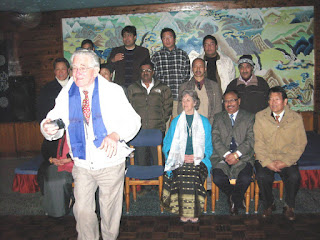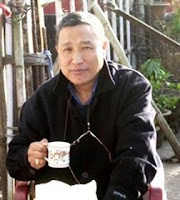A TRIBUTE Nar Bahadur Bhandari
Too late to talk about Sikkim
when battle tanks roll down Nathula and non-Sikkimese occupy seats of power
(This article is being republished as a
Tribute to Mr. Nar Bahadur Bhandari, who passed away on July 16, 2017)
Having retreated to my small corner – the
fourth estate – after quietly bidding adieu to my two-and-half-decade-long
struggle to fight for the common cause of all Sikkimese I reluctantly accepted
the offer to give a piece of my mind during a day-long seminar organized in Gangtok on January 28, 2010 by
an enthusiastic group of young people who work under the banner of All Sikkim
Educated Self-Employed & Unemployed Association.
The topic was
“Article 371F” – a dead horse which still needed more flogging! – and many of
those who were present and actively participated in the debate-cum-discussion
were distinguished personalities in Sikkim’s social, political and intellectual
circles.
 |
(L to R) Jigme N Kazi, N B Bhandari, P M
Subba and K
|
Anti-merger
veteran and former Chief Minister and President of the Sikkim unit of the
Congress party, Nar Bahadur Bhandari, was there. His former Lok Sabha MP,
Pahalman Subba, often regarded as the grand-old-man of Sikkim
Former Minister and senior Congress leader,
Kharananda Upreti, the man who accompanied Ram Chandra Poudyal during the
famous hunger strike at the lawns of the Palace in early April 1973 that led to
the Indian-backed agitation, which culminated in the signing of the historic 8th
May Tripartite Agreement of 1973,
ultimately leading to the ‘merger’ in 1975, was also present.
Among the younger politicians present at
the seminar were Padam Chettri, who only very recently took over the State unit
of the BJP as its President, Biraj Adhikari, President of Sikkim National
People’s Party, which still demands restoration of Sikkim’s pre-merger
“Associate State” status, former Communist leader and now the Convenor of Matri
Bhoomi Suraksha Sanghathan, Duk Nath Nepal, and former Minister and Convenor of
Sikkim Bhutia-Lepcha Apex Committee (SIBLAC), Tseten Tashi Bhutia, who is
regarded as one of the few vocal leaders of the minority Bhutia-Lepcha tribals.
Conspicuously absent from the scene were
representatives of the ruling Sikkim Democratic Front, which often claims that
it has restored democracy and removed fear psychosis in Sikkim after Bhandari’s
dictatorial rule (1979-1994).The truth is Pawan Chamling is now faced with the
same charges leveled by dissidents within his ruling elite.
Yesteryears’
‘revolutionary’ and one of the valiant soldiers of ‘democracy’, R C Poudyal,
suddenly turned ill and failed to come! With his absence Poudyal missed a great
opportunity to stand side by side, shoulder to shoulder with sons and daughters
of Sikkim
Let
them live on hope and die in despair. There is no space for spineless walking
corpses, who are neither black or white and who will surely fade away into
nothingness, to mingle with honourable defenders of the Sikkimese cause during
the time of crisis when the need of the hour for unity and solidarity, despite
personal and political differences, has never been felt so much.
Added to this unique and historic gathering
representing the multi-faceted Sikkimese society were Nagrik Sangarsha Samiti
Coordinator and prominent critic and member of the old business community, Prem
Goyal, Affected Citizens of Teesta (ACT) activists, Gyatso Lepcha and Mayalmit
Lepcha, former District Collector, S P
Subba, and former police officer, Jiwan Pradhan.
I not only offered my heartiest
congratulations to the organizers of the 10-hour-long marathon session but also
salute those who spoke out their mind and warmed our hearts and hopes. Together
we made history on January 28, 2010, two days before the 28th death
anniversary of the late Chogyal of Sikkim.
I was certainly the odd man out as I did
not belong to any political or non-political grouping. The organizers created
the right mood for Sikkimese from all communities and from all walks of life to
speak their heart out on an issue that is dear to them for a very long time.
That the speakers, mindless of who they were and what positions they held, spoke eloquently and with conviction and
emotion on a wide variety of subjects on one-point theme – Article 371F – is
indeed a rare treat for any viewers.
With tears in my eyes and heart full of
burden I made my stand clear. “I have no wish to dethrone anyone or help anyone
to get the top job. This is mainly because I have gracefully and very
reluctantly accepted the death of my dream,” I told the gathering.
I made it plain that the casual and
directionless manner in which the political leadership among the majority
Sikkimese Nepalese tackled the Assembly seat issue in the past so many years
led to the death of my dream of a united Sikkim, where all people live in
perfect peace, harmony, freedom and prosperity and where the country’s security
concerns were fully safeguarded.
New Delhi ought to realize by now that
security, particularly in Sikkim, depends on the loyalty of its people, not
just territorial acquisition whether by force or consent.
I took a dig as I often do when the
opportunity arises on those who often make the right noises but the wrong
moves: “I quit everything when some of my friends and former colleagues who are
educated, have some political experience and feel for Sikkim and the Sikkimese
could not look beyond Chamling and Bhandari despite the pressing need to stand
firm and pursue our common objectives.”
I warned that activities of agents of
division and disunity actively serving New Delhi, which seems least concerned
about what is happening in Sikkim besides pumping huge amount of funds (and
perhaps taking some back on the quiet) to its former Protectorate keeping the
people perpetually drugged with power and money, will not only finish Sikkim
and the Sikkimese people but greatly and surely endanger the country’s
territorial integrity.
Didn’t I make it clear in my book, “Sikkim for Sikkimese – Distinct Identity
Within the Union” (published in Feb 2009) why Sikkim is facing a crisis of
our own making: “Phony revolutions led by fake revolutionaries and democrats
have created a system that thrives on lies, deceit and corruption. We are all
victims of the ‘democracy’ that we longed for in1973 and 1993.”
We may blame the Centre for the gradual
erosion of our special status and dilution of our distinct identity. But we,
too, are responsible for failing to look after our long-term interests and live
up to the hopes and aspirations of our people.
My
message during the seminar was sharp and incisive: “It will be too late to talk
about Article 371F when battle tanks roll down Nathula pass and non-Sikkimese
occupy seats of power in Mintokgang (CM’s official residence) in the near
future.” (Sikkim Observer)
























